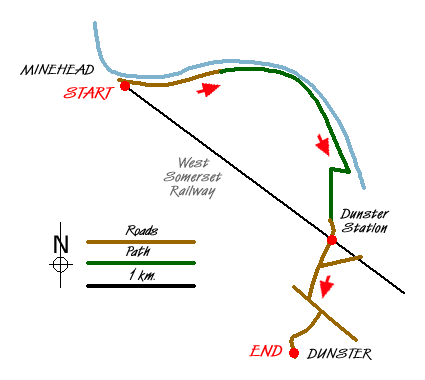Walk 2211 - printer friendly version
Minehead to Dunster Walk
Author - John Coombes
Length - 5.0 miles / 8.1 km
Ascent - 150 feet / 45 metres
Grade - easy
Start - OS grid reference SS974463
Lat 51.206663 + Long -3.4700788
Postcode TA24 5AP (approx. location only)
This Somerset walk starts at Minehead station and continues along the promenade. The route passes Somerwest World holiday camp to the beach beyond the golf club. From here, after a section along the beach, the route turns inland on quite country lanes and on into Dunster.
The Walk starts at the Somerset Steam Railway station (Grid ref. SS974463). Exit the station. Facing out to sea, turn right and carry on along the promenade passing Somerwest World holiday camp. After passing the camp, the promenade comes to an end. There is a small roundabout next to Minehead golf club. Turn right here and walk down to the golf club. At the beginning of the buildings there is a footpath to the left up to the sand dunes with a signpost marked to Dunster Beach. If the tide is out then you can walk along the main beach but should the tide be in then follow the footpath along the edge of the golf course but be sure to watch for the odd stray golf ball.
The footpath leads to two old pillboxes facing out to sea. At this point, once past the second pillbox, go through the entrance into Dunster Beach Chalets. Then turn right and follow the footpath with the stream on the left to the end. Go through the gate and turn left. Having turned left this brings you into an enclosed area between farm buildings and farmland follow the footpath to the end which comes out next to the Old Manor House on to a country lane.
Follow the lane pass Dunster station on the left and onto the start of Dunster village. There is a fork in the lane. Keep to the left and follow the lane up to the A39 main road. Turn left and then right to go down through the underpass to reach the main Dunster village area.
Notes The walk can be extended. Back at the Dunster Beach Chalets instead of turning right just follow the beach to Blue Anchor and continue along the beach to Watchet. This can only be completed if the tide is out. You return to Minehead using bus services 28 or 39. From April to October there is also a regular service on the West Somerset Steam Railway back to Minehead.
Minehead is very much a late Victorian town which came together out of three different settlements. The first was Higher Town which was a row of houses close to St Michaels Church; also in the area there are picturesque cottages very much in the West Somerset style. The narrow path known locally as the church steps is a popular area past and present for artists and photographers. Also at the bottom of the steps is the red sandstone building which was Minehead's earliest workhouse for the poor, which was leased in 1731. Lower Town grow around the mill on the stream, but in the summer of 1791 there was a fire which started with a barrel on fire from the mill at the bottom of Bampton Street this then floated down stream and set light to the thatched buildings on the way. The final result meant that there are very few old buildings in the Lower Town area. Quay Town is the last of the three and this lies beneath the steep seaward slope of North Hill. If we go back in history according to the Domesday Book Elgar Earl of Mercia held the town and harbour but was latter dispossessed by William the Conqueror's friend William de Monun of Dunster a name that is very prominent in Dunster's history.
When you are visiting Dunster the first thing that towers over the village is the spectacular Dunster Castle. It is written in the Domesday Book that a recorded fortress was on this spot and owned by the Saxon Aelfric before 1066. After the battle of Hastings in 1066 William the Conqueror granted Dunster to his friend the Norman warlord William de Mohun along with Dunster Castle which stayed in the family for more than 300 years. It was not until 1376 that Joan de Mohun sold the Castle to Lady Elizabeth Luttrell whose descendants went on own the Castle until the 20th century. The village is full of interesting history from the 16th century Luttrell Arms Hotel, which played a significant role in the Civil War, to the 16th century Priest cottage built from ship's timber. This also forms the entrance to Dunster Church dedicated to St George. The church dates back to the 13th century with the stone altar and the main body in the shape of a cross from the 15th century.

Mountain Weather
Stay safe on the mountains with detailed weather forecasts - for iOS devices or for Android devices.

